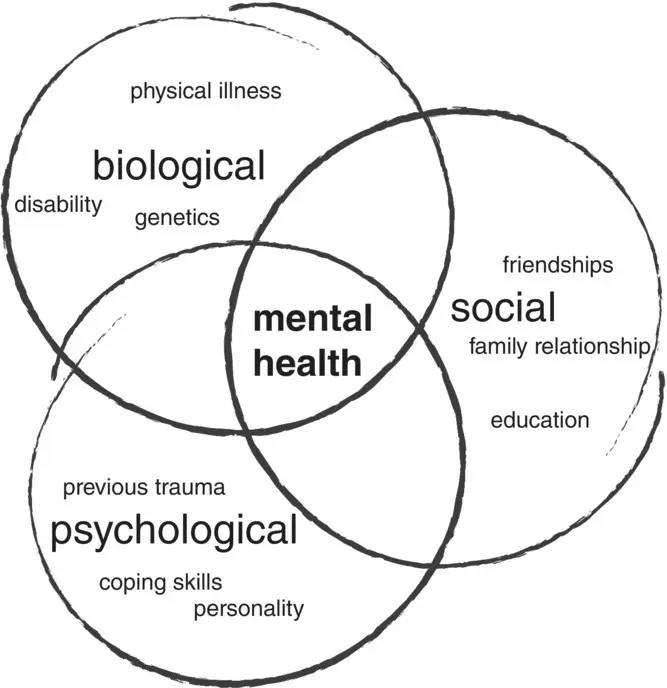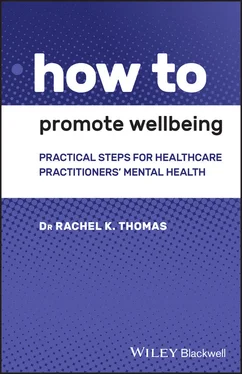Our conversations on wellbeing and mental health need to start focussing more on organisational change. However, since organisational change tends to evolve slowly, it may be useful for us to ‘put on our own oxygen mask first’, as the airline safety videos so aptly phrase it, and learn a few techniques that may help ourselves to relieve the situation on a personal level, until the required systemic changes are eventually implemented. Part of this ‘top down’ change can begin with a ‘bottom up’ approach: learning and implementing techniques on a personal level will contribute to the required attitude and institutional changes further up in the system.
It may well be that, given the significant burden of mental health across the globe, our global approach to how it is managed needs to be reviewed. Whether it is increased education in school systems or increased access to telehealth resources – there are multiple avenues for improvement. Maybe the most effective remedies will prove to be institutional as well as personal; only time will tell. In the meantime, however, we clinicians tend to, by necessity, be practical and solution focused. We also tend to appreciate an approach with different and complementary prongs – a multi‐disciplinary team approach. While reflecting on greater policy change, it makes sense to reflect not only on some of the wide issues relating to our wellbeing, but also on some of the solutions.
Problem factor: Accessing resources
The issue of the lack of adequate resources for mental health and wellbeing is universal. Across the globe 70% of the general population with a mental illness do not receive any treatment from trained healthcare staff ( Figure 1.1). 6The reasons for this are multiple and complex; however, they include:
Ignorance of presenting signs and symptoms
Ignorance of treatment access pathways
Perception around mental health
Concerns about being discriminated against.2

Figure 1.1 Around 7 in 10 of the general population across the globe with a mental illness do not receive any treatment from trained healthcare staff. 6
Approximately one‐third of global adult disability is due to issues surrounding mental health. 2So sobering are these statistics that bodies such as the WHO have responded with ‘Mental Health Action Plan’ directives. 2These include:
More effective leadership and governance for mental health
The provision of comprehensive, integrated mental health and social care services in community‐based settings
Implementation of strategies for promotion and prevention
Strengthened information systems, evidence, and research.7
As mentioned, evidence suggests that it may take almost a decade for treatment to begin for depression after depressed symptoms have first appeared. 2There is also evidence that delays in health professionals seeking treatment are greater than those of the general population. Hence the statistics for us and our colleagues could clearly be improved.
There are a range of different care options for mental health. While traditional face‐to‐face consultations with a trained clinician are key in some cases, there are a range of other, potentially more accessible treatment options that may be suitable in some cases. Some may include telemedicine, or complementary and alternative treatments. While some of these are in relative infancy, their potential is promising. Internet‐based cognitive behavioural therapy programmes aim to teach both cognitive skills – such as identifying depressogenic biases in how information is being processed – and behavioural skills, such as strategies to solve problems.
A range of factors may delay clinicians
accessing mental health and wellbeing resources .
Clinicians also may delay access to care due to concerns around confidentiality. 8There are other factors affecting how and why we access support in the way we do, as we will cover in the coming chapters.
Problem factor: Multiple potential impacts on individual mental health
The biopsychosocial (BPS) model framework is used to explore how a mental health condition has arisen. 9The BPS model outlines the broad scope of areas that impact on our mental health, and systematically shows their inter‐connections. According to this framework, there are various interconnected components that contribute to mental health conditions. These include the biological, the psychological, and the social. It shows that social parameters, the surrounding personality, and our emotional tone, as well as many other aspects all influence our mental health. 10
Some factors include ( Figure 1.2):
Biological: age, genetics, gender, disability, co‐morbid disease
Psychological: beliefs, attitudes, self‐perception, self‐esteem, coping skills
Social: friendships, occupation, employment, family relationships, social support systems, socioeconomics.

Figure 1.2 The biopsychosocial model indicates the interconnectedness between biological, psychological, and social factors that influence mental health.
Some of these aspects are modifiable; for example coping skills are highly modifiable.
Neurobiology and genomics research provide strong evidence on the complexity of the expression of mental health conditions. A simple, linear cause and effect model rarely, if ever, can explain a mental health condition. Instead, it is more like a looping and complex chain of multiple causes and effects. 10
In recognising areas that impact on our mental health, we can identify those that we can improve in order to help protect and promote our mental health. Therefore, this framework presents a way to not only look at factors that negatively affect our mental health, but to also highlight areas that contribute positively to our mental health.
Problem factor: The acute and chronic stress responses
As many of us are aware, our stress responses can be acute (quicker and shorter) or chronic (over a longer timeframe). Research supports that the implications of stress can extend beyond our physical health to our mental health, too.
An acute stress response follows the perception of a stressful event, and leads to changes in the
Endocrine
Cardiovascular
Nervous
Immune
systems. 11These changes, known as the ‘acute stress response’, or the ‘fight or flight’ response, are, when short in duration, important adaptations for our survival.
Chemical cascades are generally activated ( Figure 1.3) to:
Release energy stores for immediately available use
Distribute energy to tissues – such as the brain and skeletal muscles – which perform more actively during periods of acute stress
Redirect energy away from body activities such as growth, sex hormones, and digestion which are less critical for immediate survival.11

Figure 1.3 Stress response chemical cascade. 13
The acute stress response directs this energy around the body to places where it is required, by the dilatation and contraction of blood vessels and by the cardiac output increasing via changes to the heart’s stroke volume and rate ( Figure 1.4). 12
Читать дальше















